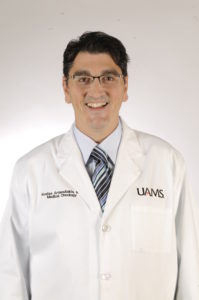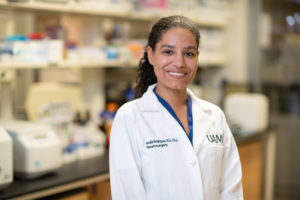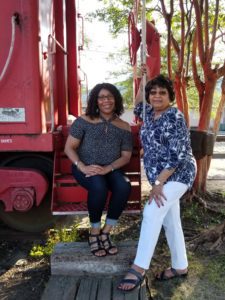Minimally Invasive Brain Tumor Removal Gives Morrilton Grandmother ‘a Second Chance’
| Mary Harris enjoys traveling with her daughters and granddaughters, and the family looks forward to their trips three times a year. And though the pandemic caused them to postpone for a while, they are ready to resume with a trip to Branson in June.
In 2016, Harris began having a continued cough and constant bronchitis. Doctors discovered she had stage 4 lung cancer that had metastasized to her brain. After chemotherapy and radiation, she was in remission for a few years. She is grateful for her treatment under the care of UAMS hematologist and oncologist Konstantinos Arnaoutakis, M.D., who treats patients in the Winthrop P. Rockefeller Cancer Institute.
In 2019, Harris started experiencing headaches. During one episode, she became unable to speak. Arnaoutakis saw there was inflammation in her brain caused by the radiation. Using UAMS’ team-based approach to care, he called on physician scientist Analiz Rodriguez, M.D., Ph.D., neurosurgeon and director of neurosurgical oncology at UAMS.
“Traditionally the type of surgery that we do is something called a craniotomy, where we make a window into the skull,” Rodriguez said. “Those windows can be various sizes. But in this case, because we were able to use MRI-guided laser ablation, the window was the size of a pencil eraser.”
UAMS is the only hospital in Arkansas that uses this minimally invasive approach. Compared to a craniotomy to remove a brain tumor, MRI-guided laser ablation can reduce pain after surgery and shorten recovery time.
“The incision I make is the width of my index finger,” Rodriguez said. “Then we attach a metal bolt to the skull and pass a laser fiber that is very thin and flexible through the brain.”
The laser heats up the targeted spot. Using an MRI, Rodriguez can see real-time pictures and direct the laser energy to heat the brain tumor. Because the incision is much smaller, healing time is quicker. Harris was able to leave the hospital a day after her surgery. Rodriguez says this approach is especially helpful for patients who are undergoing other cancer treatments.
“I am just so thankful,” Harris said. “A lot of people don’t get a second chance like I did. I’m happy to be able to spend more time with my family.”
When she is not traveling, Harris enjoys working in her yard. She comes back to UAMS every three months for a check-up.



